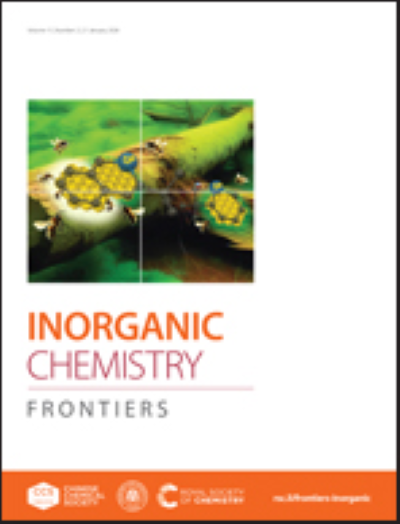推动单分子磁体的边界:利用前所未有的镧系SMM性能的更高氧化态的从头算观点
IF 6.4
1区 化学
Q1 CHEMISTRY, INORGANIC & NUCLEAR
引用次数: 0
摘要
最近获得接近液态N2温度的阻断温度的突破重新点燃了人们对镧系单分子磁体(SMMs)最终用户应用的兴趣。在这一领域,存在一些挑战,其中一个关键目标是进一步提高阻断温度。由于目前基于DyIII的分子已经达到磁化逆转的最大势垒高度(Ueff),基于化学洞察力的发展受到阻碍。在这方面,我们利用密度泛函理论(DFT)和从头算完全主动空间自洽场(CASSCF)方法,探索了获得+4和+5等高价氧化态镧系smm的可能性。我们从[LnO2]+, [LnO2]和[LnO2]−(Ln从Ce到Lu不等)系统的各种小型模型开始,将镧系元素的性质与SMM特征联系起来。我们还扩展了我们的研究,包括先前报道的具有+4和+5氧化态的五种配合物,以提供改善SMM特性的线索。我们的计算揭示了镧系smm中微调氧化态的几个优势,这包括(i)与LnIII相比较,镧系配体共价增加;(ii)磁化反转的产率势垒高度高达8424 cm−1,这是任何模型中前所未有的值;(iii)在各种稳定这种高氧化态的方法中,封装产生几个目标。与HoO2@SWCNT(4, 4)预计将产生一个令人印象深刻的能量势垒~ 5400厘米⁻¹(iv)强lanthanide-ligand债券也发现淬火自旋声子弛豫,抵消振动导致这种放松。这可能产生更大的阻断温度,为新型镧系smm提供了一种新策略。本文章由计算机程序翻译,如有差异,请以英文原文为准。
Pushing Boundaries in Single Molecule Magnets: An Ab Initio Perspective on Harnessing Higher Oxidation States for Unprecedented Lanthanide SMM Performance
The recent breakthrough of attaining blocking temperature near liquid N2 temperature rekindled the interest in lanthanide-based Single Molecule Magnets (SMMs) towards end-user applications. Within this realm, several challenges are present, with a key objective being the further enhancement of the blocking temperature. As the current set of molecules based on DyIII has already reached their maximum potential barrier height for magnetization reversal (Ueff), chemical insights-based developments are hampered. In this connection, using Density Functional Theory (DFT) and ab initio Complete Active Space Self-Consistent Field (CASSCF) methods, we have explored the possibility of obtaining lanthanide SMMs in high-valent oxidation states such as +4 and +5. We begin with various small models of [LnO2]+, [LnO2], and [LnO2]− (Ln varying from Ce to Lu) systems to correlate the nature of the lanthanides to the SMM characteristics. We have also extended our study to include five complexes reported earlier possessing +4 and +5 oxidation states to offer clues to improve the SMM characteristics. Our calculations reveal several advantages in fine-tuning the oxidation states in lanthanide SMMs, and this includes (i) the lanthanide-ligand covalency found to increase as compared to the LnIII counterpart (ii) yield barrier height for magnetization reversal as high as 8424 cm−1, an unprecedented value among any models reported (iii) among various ways to stabilize such high-oxidation states, encapsulation yields several targets, with HoO2@SWCNT(4,4) predicted to yield an impressive energy barrier of ~5400 cm⁻¹ (iv) stronger lanthanide-ligand bonds were also found to quench spin-phonon relaxation, as they offset the vibrations that cause this relaxation. This potentially yields larger blocking temperatures, offering a novel strategy for a new class of lanthanide SMMs.
求助全文
通过发布文献求助,成功后即可免费获取论文全文。
去求助
来源期刊

Inorganic Chemistry Frontiers
CHEMISTRY, INORGANIC & NUCLEAR-
CiteScore
10.40
自引率
7.10%
发文量
587
审稿时长
1.2 months
期刊介绍:
The international, high quality journal for interdisciplinary research between inorganic chemistry and related subjects
 求助内容:
求助内容: 应助结果提醒方式:
应助结果提醒方式:


